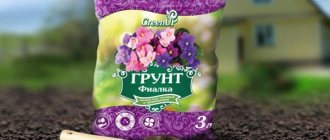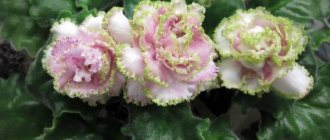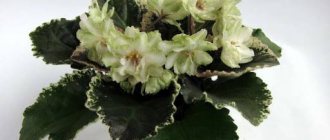The Almond variety violet, also most often known as a “seedling,” is distinguished by the fact that very large flowers, colored pink, are formed on the bush. This variety was bred by one of the most famous breeders of our country - Konstantin Morev. He is the author of more than a hundred varieties and varieties of violets, which today enjoy great love and popularity among flower growers. The flowers of this variety differ from many others in that they have a very unusual and original shape of the petals, and the color of these flowers can change depending on what conditions and what microclimate were created by the grower when caring for the plants.
In this article we will dwell in more detail on the description of the most basic characteristics of this violet variety, and will also try to talk in more detail about the intricacies of planting maintenance and subsequent care of the plant so that it receives maximum care and attention from the grower. This article will be very useful especially for novice gardeners, since the care and agricultural technology of violets very often coincide, and if the gardener takes into account the subtleties of planting and caring for Almond violets, then it will be quite easy for him to plant and care for plants of other varieties and varieties in the future.
Description of the variety and photographs of violet Almond
Photos and descriptions of the Almond variety impress even those gardeners who have never grown violets in their apartment. Huge, up to 8-9 centimeters in diameter, pink-peach stars with a white eye in the center and a white border along the edge of the wavy petals are surrounded by dark green leaves. The flower petals are gracefully curved and retain their shape thanks to their dense texture.
The rosette of the variety is large, 30-40 centimeters, but compact, thanks to the leaves hugging the pot. The leaves of the variety are dark green, with a shiny surface, rounded in shape. There are faint serrations along the edges of the leaves.
[adsp-pro-4]
A maximum of 3 buds are formed at the same time in the center of the rosette; 1-2 of them are constantly in bloom. But due to their size, the bloomed flowers look like a whole bouquet. The peduncles of the variety are not thick, but strong, so they bend a little under the weight of the buds. But the flowers don't fall on the leaves. Each flower remains in bloom for about a month.
Violet SM-Almond (Seedling Morev)
History of the variety
Saintpaulia SM-Almond is a seedling of the famous domestic breeder Konstantin Morev .
Despite the fact that Konstantin did not make this hybrid of Uzambara violet a variety, SM-Almond for its bright and large flowers became very popular among:
- Violet collectors;
- And lovers of indoor flowers.
Photo and description of the variety
Violet Moreva Almond is an Uzambara violet that belongs to the Gesneriev family . The Almond seedling delights not only beginners, but also experienced violet growers. Simply huge flowers up to 8-9 cm, amaze not only with their size, but also with their changing color depending on the conditions of detention.
Flowers are found in two color options . In the first case they are a rich coral color, and in the second they are soft peach. Double stars also have a white center, and the edges of the petals are gracefully curved and lighter than the middle.
Violet Almond has two different flower colors.
Attention! Thanks to the dense structure of the petals, the flowers retain their shape throughout the entire flowering period.
Socket:
- Compact and symmetrical;
- Easy to form;
- It has a standard size of 30 to 40 cm in diameter.
Leaves:
- Shiny;
- Round shape;
- Dark green color;
- The edges of the foliage have faint serrations.
Saintpaulia has dark green leaves.
Variegation, imprints
The rosette and leaves are of a standard dark green color, without variegation .
Rules of maintenance and care
Like most large-flowered varieties, Almond violet is capricious. Therefore, growing a specimen that matches the description of the variety is quite difficult. The outlet needs to be provided with almost ideal conditions and increased attention.
The formation of large flowers of interesting color and a symmetrical, developed rosette can be achieved by ensuring the following conditions:
- Optimal temperature. Violet Almond is temperature dependent. In the heat, the color of the petals becomes monotonous, without whiteness in the center and along the edge. The flowers have a characteristic color for the variety at a temperature of 20-24 degrees. Critical temperatures for violets are below 13 and above 28 degrees.
- Sufficient lighting. Violet Almond is sensitive to light levels. The ideal place for growing it is an east window or a shelf illuminated by a fluorescent lamp. North-facing windows are not suitable for the plant. To properly form a rosette, turn the pot to the light source with the other side every 3-4 days.
- In order for the Almond violet to bloom in large flowers, you must follow all care recommendations.
Moderate watering. Waterlogged soil is the main enemy of this variety. Even a short stay in too wet soil negatively affects the well-being of the plant and causes rotting of the roots. Experienced gardeners recommend growing this variety using wick irrigation.
- Air humidity is not less than 50 and not more than 70%. You can increase the humidity level by placing the pot on a tray of expanded clay filled with water. In this case, the bottom of the pot should not touch the water. Excessive humidity is eliminated by regular ventilation.
- Maintaining leaf hygiene. Once a month, the violet is given “bath procedures.” The plant is placed in a bathtub and washed with a weak stream of warm water. The violet can be returned to the windowsill only after the leaves have completely dried.
Rules for care and maintenance
Proper care of the almond violet (photos and descriptions of the culture can be found in the previous section) will allow you to achieve beautiful and long flowering of this crop. However, it should be borne in mind that the variety is very capricious and accepts only those conditions that are close to ideal:
- room temperature – from 20 to 24 degrees;
- daylight hours – 18 hours;
- the nature of watering is moderate;
- air humidity – 60%.
In addition, every gardener must monitor the hygiene of the leaves, giving the violet “bath procedures” or wiping the plates with a damp cloth to remove dust. You can return the flower to the windowsill only when it is completely dry. Otherwise, the leaves may get sunburned.
Features of feeding
Violet is extremely sensitive to the level of nutrients in the soil. The plant receives its main nutrition from the substrate, which is recommended to be changed annually. When transplanting into the soil, it is recommended to add simple mineral fertilizers as a source of basic substances: nitrogen, phosphorus and potassium. For violets, use Superphosphate - a teaspoon per liter of soil substrate.
[adsp-pro-5]
1.5-2 months after transplantation, root feeding begins with two types of liquid fertilizers:
- Organic is the main source of nitrogen. Organic fertilizers are applied to the soil at the stage of violet rosette formation, since nitrogen promotes the growth of green mass. At home, it is recommended to use Gumi, Raduga, and Ideal fertilizers. The use of microbiological fertilizer Baikal EM1 gives good results.
- Complex minerals - special mineral mixtures for violets or universal preparations in the form of powders or liquids. Mineral supplements contain phosphorus and potassium, which are necessary for the formation of buds and abundant flowering. For violets, it is recommended to use fertilizers Master, Fertika, Bona Forte, Uniflor.
For lush flowering, Almond violets must be fed.
Advice. Violet almond responds positively to monthly watering with a weak solution of potassium permanganate. It serves as a source of potassium and manganese, slightly increases the acidity of the soil and washes out excess salts from it.
Rules for transplanting violets Almonds
It is necessary to replant the almond violet twice a year, since the plant’s stem quickly becomes exposed and the rosette loses its decorative effect. When replanting, the violet stem must be buried to the level of the lower leaves, but in such a way that they do not touch the soil.
By the fourth year of life, the stem lengthens so much that it is necessary to rejuvenate the rosette. To do this, remove the bottom row of leaves and cut off the crown of the rosette, leaving a 3-4 centimeter long stem under the second row, and plant the violet in a loose substrate. The crown quickly takes root, and the rosette begins to actively grow new leaves.
To grow violets, use pots with a diameter of no more than 13 centimeters. Young rosettes are planted in containers from 6 to 9 centimeters. The size of the pot grows along with the increase in the root rosette.
Important. You cannot immediately plant young plants in large pots and expect them to grow. If there is room for the roots in the container, the violet will begin to grow roots and leaves, but will not bloom.
Young violets Almonds should not be planted in pots that are too spacious.
The substrate for planting violets should be as loose and light as possible. If you do not want or have the opportunity to purchase ready-made soil for violets, you can prepare the soil yourself. It is necessary to mix 5 parts of turf and leaf soil, 3 parts of peat, 1 part of sand. To loosen, add vermiculite or perlite to the mixture (10% of the volume of the mixture).
Transplanting and pruning violets of the Almond variety
Violet Almond: photo
It is recommended to replant the almond violet variety into a new container about twice a year, since the plant is characterized by gradual exposure of the trunk, and because of this, the rosette may lose its decorative qualities. When transplanting, the stem is buried back into the soil mixture, but to the level of the lowest leaves. It is important that the lower leaves do not touch the soil, otherwise this may cause some irritation, and when watering, the moisture will touch the leafy part, which is generally strictly contraindicated in this matter.
When a violet reaches the age of four years, its trunk can become very long, and therefore experienced gardeners recommend rejuvenating pruning of the rosette to rejuvenate it and give it a second life. To do this, the bottom row of leaves is completely removed, and the crown of the rosette is trimmed. Under the second row you should leave a small stem, the length of which can be from three to four centimeters. The violet is then placed in a new loose substrate, which in its composition should be ideal for this particular crop. The crown of the violet takes root very quickly, and the rosette is capable of growing completely new leaves within a short period of time, which look very fresh, so you can’t even immediately tell that the base of the crop is already aged. In order to grow violets, you should take care of the container and its size. Pots with a diameter of no more than thirteen centimeters are ideal. If these are very young rosette seedlings, then they are planted in small pots of six to nine centimeters. The size of the pot changes as the violet itself grows, but initially the pot should be small. If you choose a container that is too large, the violet will tend to cover the entire earthen ball with its roots, and the plant simply will not have the strength to grow green leaf mass. Therefore, in this case there can be no talk of any decorativeness or flowering at all. Absolutely all flower growers should remember this point, in particular those who do not yet have some experience in growing violets, and therefore they find information about all the rules and subtleties.
The substrate for planting violets must be very loose, light, breathable and susceptible to moisture. If the gardener does not have a special desire and opportunity to purchase ready-made soil in stores and nurseries, then you can prepare the soil for violets yourself. To do this, the following components are thoroughly mixed: turf and leaf soil, peat, sand. To make the soil mixture even looser, it is also recommended to add a little perlite or vermiculite to the soil. They should make up about ten percent of the total volume of the resulting mass.
Problems and mistakes when growing plants
Violet Almond is quite capricious. If the rules for its cultivation and care are not followed, there is a risk of plant death or lack of flowering.
[adsp-pro-6]
The following signs indicate problems:
- Brown spots on the leaves are the result of watering with cold water or sunburn.
- Yellowing of leaves - overexposure, too dry and humid air.
- Gray plaque on the leaves is gray rot. Temperature too low with high humidity.
- Pale green leaves with edges curving downwards mean the temperature is too low, most often at night.
- Rapid growth of foliage and shoots in the absence of flowering - lack of light, excess nitrogen, too spacious pot. This phenomenon can occur when stepsons are not removed in a timely manner.
- Plaque and spots on the leaves indicate the development of violet disease.
Limp leaves with sufficient moisture in the soil are fusarium.
- White coating on leaves and peduncles is powdery mildew. The cause of infection by this fungus is low temperature and high humidity.
- Brown or red spots on the leaves and lumps of fluff in the axils are scales.
- Sticky coating on the surface of the leaves and brown dots on the bottom are aphids.
- Deformed leaves with depressed red or yellow spots, a compacted center of the rosette - mites.
When the first signs of disease development appear, the violet must be sprayed with an insecticide or fungicide. First, you need to remove all damaged parts from the violet and replant it in a new pot with a complete replacement of the soil. Urgent measures must be taken immediately when the first signs appear, otherwise the plant cannot be saved.
Reproduction methods
Violet almond is a bit difficult to reproduce. Stepchildren rarely give rosettes on their own. To get daughter rosettes, you need to pinch the growth point of the main rosette and at the same time add nitrogen fertilizer to the soil. This technique stimulates the formation of daughter shoots - stepchildren - in the axils of the lower leaves.
As soon as 2-3 leaves with cuttings of at least 3-4 centimeters grow on the resulting stepsons, they are separated from the mother plant and planted for rooting in a mixture of sand, peat and vermiculite. The top of the stepson is covered with a transparent cap. Experienced gardeners also advise rooting stepsons in damp sphagnum moss placed in plastic containers with a lid.
Important. In order not to damage the stepson's growth point, it is separated from the mother's rosette using an awl, scalpel or toothpick. You need to cut off the stepson at the point where it is attached to the leaves of the mother's rosette.
Violet Almonds are best propagated by separating the stepsons.
An alternative way to propagate violets is by rooting leaf cuttings. A healthy, well-developed leaf from the second row of the rosette is cut obliquely with a sharp knife or blade and placed in a glass of water. After the formation of roots 1-1.5 centimeters long on the cuttings, it is planted in a cup filled with loose substrate.
Babies on cuttings with pre-grown roots are formed in 4-5 weeks. You can separate them from the cuttings and plant them in pots only after the diameter of the leaves reaches 3-4 centimeters.
How does the violet variety Almond propagate?
Violet Almond: photo
The Almond Moreva violet variety may experience some difficulties in propagation. Stepchildren grow on their own extremely rarely, and this can be associated with some specific features and characteristics of this variety. In order to still get daughter rosettes from violets of this variety, it is recommended to pinch the growing point of the main rosette and add nitrogen-containing components and fertilizers to the soil at the same time. Thanks to this procedure, the grower will be able to stimulate the formation of daughter shoots in the axils of the lower leaves - accordingly, the varietal stepchildren that we expect will be formed.
As soon as two to three full-fledged leaves are formed on the stepsons, and the cuttings reach four centimeters in length, they can be further separated from the mother plant; they are placed for further rooting and growth in a separate container, which is pre-filled with a mixture that includes sand and peat, vermiculite, so that the soil is light and very loose. It is recommended to cover the stepson with a small transparent plastic cap on top to form a dome and greenhouse conditions. Experienced violet breeders also recommend rooting stepsons in damp sphagnum moss, which is placed in plastic containers with a lid. In general, sphagnum moss is very favorable to violets, and you should pay attention to it, because it can give an excellent impetus to the development of the plant, and the Almond violet will continue to grow and develop well in absolutely any conditions.
In order not to harm the growth point of the Almond violet's stepson when pinching, it is recommended to separate it from the mother's rosette using a scalpel or toothpicks, as well as an awl, but it is recommended to first disinfect the tools so as not to introduce bacteria into the pinching area. It is also recommended to cut off the stepson exactly at the point at which it is actually attached to the leaves of the mother rosette, then the risk that the grower will cause some damage to the planting will be reduced.
There is another, more alternative way, thanks to which you can propagate violets of such a whimsical variety as the Almond violet. To do this, you can root the leaf cuttings. A leaf that looks developed and healthy must be cut from the second row of the rosette, while the cut is made at a slight angle; a well-sharpened and disinfected tool is used for the cut - a blade or knife. After this, the leaf is placed in a glass of warm, settled water. After roots are formed on the cuttings, the length of which will be from one to one and a half centimeters, the leaf is moved into a container with a substrate. The substrate must be very loose and light, allowing moisture and air to pass through.
Children on the cuttings are formed approximately five weeks after the Almond violet has been placed in the ground. You can separate the babies from the cuttings and plant them in separate containers only after the diameter of the leaves reaches at least three to four centimeters. Otherwise, they will be too weak, and there is a high probability that they will not survive this planting at all; immediately after separation they will wither and die. In general, in general, there are mostly positive reviews about this variety, even despite the fact that some gardeners are faced with the whimsical nature of planting, with its needs for constant care and supervision. But we can assure you that even inexperienced gardeners, if they follow the basic rules, will be able to achieve excellent results in growing this plant, so there is simply no doubt about it. The most important thing is to water the planting on time, apply the necessary fertilizing, prune, this is also required. Replanting is a necessary measure if the Almond violet has outgrown its container, or if suddenly the soil mixture in the container has become too dry and lifeless. It is also worth taking care of the proximity of violets - they react remarkably well to other indoor crops, but you should look after each bush, inspect the leaves and stems, buds for diseases and pests.
Reviews from flower growers about violet Almond
Lyra. Violet is too capricious and needs a lot of attention. Something just goes wrong, the leaves begin to curl. But such a huge flower is worth it. The violet is difficult to reproduce and reluctantly produces children when the leaves take root.
See the description of the Black Pearl violet and read reviews about the variety.
Violet First date: description of the variety in the full article.
Natalie . When I first came across a description of the violet variety Almond, I didn’t believe that there could be such large flowers. But I decided to check it out, and a miracle happened. The starter produced a flower of 6.5 centimeters. The second flowering pleased me with a flower of about 8 centimeters. I’m waiting for the third flowering, but already now I’m one hundred percent satisfied with the variety. The flower has an original shape, pink-salmon color, white edges of the petals. Beauty!











